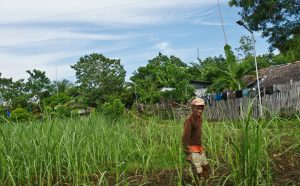Earlier this month a pair of courts in the Philippine province of Negros Occidental issued restraining orders against a government plan to import 200,000 metric tons of refined sugar. In both cases, the petitions were filed by farmers’ associations representing local sugar producers. Opposition politicians are now calling for a probe into the permits, while on the consumer side the Philippine Chamber of Food Manufacturers (that is, the people who actually buy and use refined sugar) have lobbied for the imports to go through as planned. What is going on in the Philippine sugar industry?
Well, it’s a pretty classic balancing act between the interests of domestic farmers and the welfare of consumers. And with an election coming up it’s a good bet that however this balances out, politics will play some role in the whole thing.
Agriculture is very important to the socioeconomic structure of the Philippines. According to the Asian Development Bank, although the agricultural sector only accounted for 10 percent of GDP in 2020, it employed about 25 percent of the working population. And Negros is the largest sugar-producing region in the Philippines. From the perspective of these sugar farmers, the main goal is to have their product absorbed by the domestic market at a stable price (which is usually somewhat higher than international prices, since they don’t need to compete with global sugar producers).
Paying a premium on domestically produced sugar is tolerated by political economic actors because it helps prop up an agricultural base that absorbs a quarter of the workforce. But in recent years, the demand for sugar has been outpacing the ability of producers to keep up. According to the Sugar Regulatory Administration, from September 2017 to August 2018 sugarcane production in the Philippines declined by 417,000 metric tons compared to the previous year. This squeeze on supply caused the price of a kilogram of refined sugar to jump from 53 to 64 pesos.
To alleviate upward pressure on prices, the Sugar Regulatory Administration increased the supply of sugar through imports. In the 24-month period from September 2018 to August 2020 the Philippines imported 735,000 metric tons of refined sugar (in the previous 12-month period, they imported none). As expected from the way supply and demand work on prices, a kilogram of refined sugar quickly fell back to 50 pesos.
A similar story played out in the rice market. In 2018 the retail price of milled rice started spiking after years of relative stability, jumping to 47.15 pesos per kilogram in the fourth quarter. This was followed by a sharp increase in rice imports to bring the price down. By 2019, the Philippines was importing over $1 billion worth of rice, compared to just $339 million in 2017. And it worked, with retail prices falling back to 41.3 pesos per kilogram by the first quarter of 2020. With prices stabilized, the government moved to limit imports at the end of last year so that the market could absorb more domestically produced rice.
We are seeing the same protectionist tendencies assert themselves in the sugar industry. Only it’s somewhat complicated, because while the government does not want to upset local sugar producers or the workers they employ, it also needs to keep a careful eye on inflationary pressures that are pushing up consumer price indexes all around the world right now. And that pressure is starting to hit staple consumer goods in the Philippines. According to the Sugar Regulatory Administration, over the last six months the price of refined sugar has jumped back up to 59 pesos per kilogram.
If the past is any guide, the play here would be to push prices down again through more imports. But that move is being blocked, at least for the moment, in order to protect the interests of sugar producers. For now, the two sides are at a bit of a stalemate, with the courts in Negros Occidental blocking the way. But if inflationary pressure continues to push up the price of staple goods like rice and sugar, how long can producers hold the line in the face of rising costs? And how will the election influence this situation? We don’t know yet, but the way in which this situation resolves itself will give us some clues about where the balance of power lies between the state, producers, and consumers in the Philippines.

































